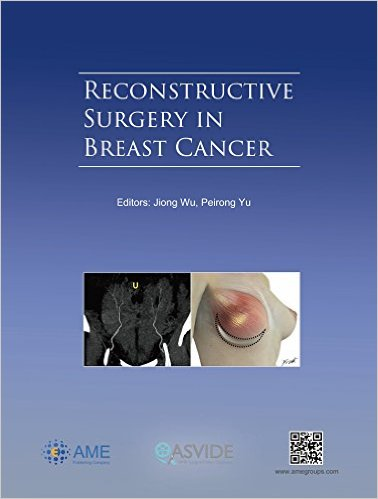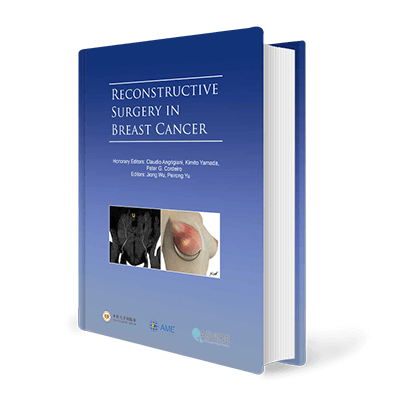
Reconstructive Surgery in Breast Cancer
| Editors: | Jiong Wu, Peirong Yu |
Publisher: AME Publishing Company; 1st edition (2017)
ISBN-13: 978-9881402820
Hardcover: 629 pages
Language: English
The categories of this book varies from anatomy to preoperative evaluation, surgical approaches, and the state-of-art breast reconstructive technologies in a systematic fashion.It is a book that surgeons, residents and students will have access to high quality, current, state-of-the art, and up-to-date information on planning, & performing autologous, prosthetic, and oncoplastic procedures for breast reconstruction following mastectomy or conservative treatment.
Honorary Editors
| Claudio Angrigiani | Division of Plastic Surgery, Hospital Santojani, Buenos Aires, Argentina |
| Kimito Yamada | Department of Breast Oncology, Tokyo Medical University Hospital, Tokyo, Japan |
| Peter G. Cordeiro | Plastic and Reconstructive Surgery Service, Department of Surgery, Memorial Sloan-Kettering Cancer Center, New York, USA |
Editors
| Jiong Wu | Department of Breast Surgery, Fudan University Shanghai Cancer Center, Shanghai 200032, China; Department of Oncology, Shanghai Medical College, Fudan University, Shanghai 200032, China; Collaborative Innovation Center for Cancer Medicine, Guangzhou 510060, China |
| Peirong Yu | Department of Plastic Surgery, The University of Texas, MD Anderson Cancer Center, Houston, TX, USA |
Table of Contents
Preface
Local/Regional Anatomy in Reconstructive Breast Surgery
1 The venous anatomy of the abdominal wall for Deep Inferior Epigastric Artery (DIEP) flaps in breast reconstruction
20 Anatomy relevant to conservative mastectomy
28 Anatomic and physiological fundamentals for autologous breast reconstruction
46 Anatomy of the nipple and breast ducts
Preoperative Evaluation
51 Essential elements of the preoperative breast reconstruction evaluation
55 Preoperative digital mammography imaging in conservative mastectomy and immediate reconstruction
Conservative Mastectomies—SSM, NSM and Mastopexy w/wo Reduction
61 Nipple areola complex sparing mastectomy
74 How to perform a NAC sparing mastectomy using an ADM and an implant
80 Using intraoperative laser angiography to safeguard nipple perfusion in nipple-sparing mastectomies
89 The evolution of mastectomies in the oncoplastic breast surgery era
94 Oncological safety of prophylactic breast surgery: skin-sparing and nipple-sparing versus total mastectomy
103 Oncologic safety of conservative mastectomy in the therapeutic setting
113 Introduction to conservative mastectomies
116 Skin-sparing mastectomy
129 Surgical decision making in conservative mastectomies
135 Conservative mastectomies: an overview
139 What is the evidence behind conservative mastectomies?
Oncoplastic Breast Surgery-Strategy, Techniques and Training
152 Training the oncoplastic breast surgeon—current and future perspectives
154 Evaluating the feasibility of extended partial mastectomy and immediate reduction mammoplasty reconstruction as an alternative to mastectomy
157 Oncoplastic breast surgery: indications, techniques and perspectives
172 Oncoplastic breast conserving surgery
177 Oncoplastic options in breast conservative surgery
184 An example of lumpectomy for lower inner quadrant breast cancer with 1st level oncoplastic reconstruction by glandular splitting
187 Oncoplastic breast surgery for centrally located breast cancer: a case series
199 Oncoplastic technique in breast conservative surgery for locally advanced breast cancer
205 Oncoplastic breast surgery in Australia and New Zealand—2014 and beyond
209 Oncoplastic volume replacement techniques according to the excised volume and tumor location in small-to moderate-sized breasts
217 International oncoplastic breast surgery training
220 Oncoplastic breast surgery: current strategies
230 Immediate breast volume replacement using a free dermal fat graft after breast cancer surgery: multiinstitutional joint research of short-term outcomes in 262 Japanese patients
246 Oncoplastic volume replacement technique for the upper inner quadrant using the omental flap
253 Oncoplastic techniques in breast surgery for special therapeutic problems
Implant Breast Reconstruction and Alloplastic Adjuncts
261 Direct-to-implant breast reconstruction
264 Alloplastic adjuncts in breast reconstruction
280 Prosthetic breast reconstruction: indications and update
293 The biplanar oncoplastic technique case series: a 2-year review
299 Evolution and update on current devices for prosthetic breast reconstruction
313 Current strategies with 1-stage prosthetic breast reconstruction
318 Current opinions on indications and algorithms for acellular dermal matrix use in primary prosthetic breast reconstruction
327 Current strategies with 2-staged prosthetic breast reconstruction
335 Conservative mastectomies and immediate reconstruction with the use of ADMs
345 Risk-reducing, conservative mastectomy—analysis of surgical outcome and quality of life in 272 implantbased reconstructions using TiLoop® Bra versus autologous corial flaps
353 Implant-based breast reconstruction following conservative mastectomy: one-stage vs. two-stage approach
Autologous Breast Reconstruction
LDF and Evolving Related Tissue Flaps
361 The evolving breast reconstruction: from latissimus dorsi musculocutaneous flap to a propeller thoracodorsal fasciocutaneous flap
365 Propeller thoracodorsal artery perforator flap for breast reconstruction
372 Use of latissimus dorsi muscle onlay patch alternative to acellular dermal matrix in implant-based breast reconstruction
379 Extended thoracodorsal artery perforator flap for breast reconstruction
Free Abdominal Perforator Flap—Preoperative Imaging Evaluation and Surgical Techniques
388 Magnetic resonance angiography in perforator flap breast reconstruction
403 Preoperative computed tomography angiography for planning DIEP flap breast reconstruction reduces operative time and overall complications
409 Comparative study of software techniques for 3D mapping of perforators in deep inferior epigastric artery perforator flap planning
417 Three routine free flaps per day in a single operating theatre: principles of a process mapping approach to improving surgical efficiency
425 Increasing options in autologous microsurgical breast reconstruction: four free flaps for ‘stacked’ bilateral breast reconstruction
431 The microvascular anastomotic coupler for venous anastomoses in free flap breast reconstruction improves outcomes
436 Nipple-areola complex reconstruction
444 Bilateral breast reconstruction with bipedicle transverse rectus abdominis myocutaneous (TRAM) flap for simultaneous delayed and immediate breast reconstruction after therapeutic modified radical mastectomy and prophylactic nipple sparing mastectomy
447 Achieving ideal breast aesthetics with autologous reconstruction
458 Abdominal perforator vs. muscle sparing flaps for breast reconstruction
468 Comparative analysis of fluorescent angiography, computed tomographic angiography and magnetic resonance angiography for planning autologous breast reconstruction
483 Conservative mastectomies and Immediate-DElayed AutoLogous (IDEAL) breast reconstruction: the DIEP flap
Radiation Therapy, the Influence on Reconstructive Breast Surgery and Vise-vesa
491 Radiotherapy and breast reconstruction: oncology, cosmesis and complications
500 Immediate breast reconstruction: does the pathology affect the reconstruction?
502 Minimizing incisional dehiscence following 2-stage prosthetic breast reconstruction in the setting of radiation therapy
505 Current perspectives on radiation therapy in autologous and prosthetic breast reconstruction
Complications and its Management in Breast Reconstructive Surgery
515 Achieving ideal donor site aesthetics with autologous breast reconstruction
524 Does immediate reconstruction increase postmastectomy surgical site infection?
526 The role of the physiotherapy in the plastic surgery patients after oncological breast surgery
531 Metabolic syndrome and outcome after breast reconstruction
534 A multiple logistic regression analysis of complications following microsurgical breast reconstruction
540 Lymphatic mapping and lymphedema surgery in the breast cancer patient
553 Breast reconstruction following conservative mastectomies: predictors of complications and outcomes
An Update and Forecast in Reconstructive Breast Surgery—Fat Grafting and Tissue Engineering
566 Stem cell and tissue engineering in breast reconstruction
573 Fat grafting and breast reconstruction: tips for ensuring predictability
Comparison of Breast Reconstruction between Chinese and American Cancer Centers
585 Current status of breast reconstruction in China: an experience of 951 breast reconstructions from a single institute
594 Breast reconstruction at the MD Anderson Cancer Center



